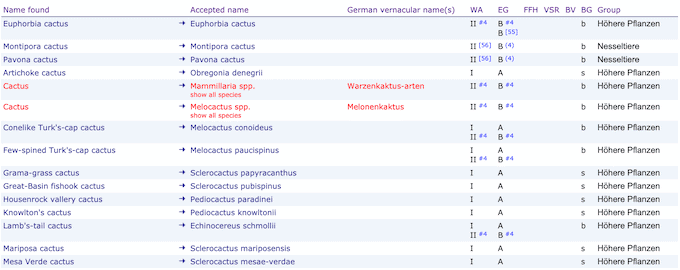Can you bring flowers & plants in your hand luggage?
Flowers and plants are generally allowed in hand luggage within the EU. There is no law or specific rule that would generally prohibit transport in hand luggage.
Within the EU it is usually tolerated if you transport the flowers & plants into some soil. However, you are not allowed to import soil from third countries into an EU country.
In addition, you must also be aware that there are flowers and plants that fall under the species protection. In this case, the provisions of the Washington Convention on International Trade in Endangered Species of Wild Fauna and Flora (CITES) must be observed.
As a rule, the import and export from/to the EU of these products requires specific import and/or export documents, depending on which appendix (I, II, III) the plants (flowers) are listed under in CITES. The situation is rather complex.
Special care should be taken with CACTI and ORCHIDS. All cactus species are under species protection and may therefore never be imported into the EU or exported from the EU without a corresponding permit.
The situation is similar with orchids. However, exemptions exist for some types of orchids.
Depending on the country, there may also be additional restrictions for certain agricultural products. This must be clarified in advance at the embassy of the respective destination country.
Contents
What else needs to be considered during transport?
To ensure that the transport of flowers and plants in hand luggage goes smoothly, please also note the following:
Transport must not take place in water, as liquids in hand luggage are regulated in accordance with the regulations for liquids in hand luggage. One possibility, however, would be to transport an empty bottle in your hand luggage and fill it with water after the security check.
Filling such a bottle with water after the security check is definitely not a problem. I have often done this myself. But if this is tolerated with the plant, you would have to find out for yourself:=)
While the transport of flowers (of course also cut flowers) and plants in hand luggage is generally allowed, you have to make sure that they do not protrude from hand luggage.
This is because the maximum permitted dimensions for hand luggage must also be respected for plants. You will find the permitted dimensions and maximum weight for all well-known airlines in our epic list.
Based on the second point it has to be added that you have to stow the plant IN your hand luggage, as most airlines only allow ONE personal item (such as a laptop bag or handbag) and ONE accessory (umbrella, reading material, etc.) on board in addition to the regular hand luggage (trolley, backpack).
However, plants are not usually considered as personal items or accessories.
What about flower seeds and plant seeds?
In general, seeds may also be transported within the EU. However, if the plant species is under species protection, then the CITES regulations also apply to the corresponding seeds of the plants.
If you want to export the seeds from the EU or import them into the EU, then you also need the corresponding CITES certificates.
Flowers and plants in your checked baggage?
Transport of flowers in checked baggage is fine. The same rules apply as for transport in hand luggage. However, the rule for liquids in hand luggage does not apply.
The question is whether the plant will survive the flight in checked baggage without any damage or not. If you can answer this question for yourself with Yes, then a carriage in checked baggage is probably even to be preferred.
On the Internet, for example in forums on the subject, you will often read, however, that you can easily import seeds without corresponding documents. This is not true.
But it seems as if the control in this respect often leaves something to be desired…but if you want to be on the safe side, then please note: Also for seeds, if there is not a special rule for your plant (flower), you must have the appropriate papers for import and export.
Where can I find more information on this subject?

Excerpt from the CITES database WISIA of the German Federal Agency for Nature Conservation (BfN), where I searched for the keyword cactus. The database lists all cacti that are protected according to the Washington Convention on International Trade in Endangered Species of Wild Fauna and Flora.
The abbreviation WA stands for Washington Convention on International Trade in Endangered Species of Wild Fauna and Flora (CITES) and the Roman numerals correspond to the appendix (I, II or III) in which the species is listed. The abbreviation EG stands for the implementation of the WAs in the European area.
Annex I essentially corresponds to EC A, Annex II to EC B and Annex III to EC C.
The subject of flowers and plants in baggage is far more complex than one might first assume.
To find out whether your plant (flower) is under species protection or not, please visit the WISIA website of the Federal Agency for Nature Conservation.
Enter the name of your plant/flower in the search field “Search for species name” in the upper left corner. If you can’t find anything in the database, you’ve been lucky.
Your plant/flower is most likely not under species protection and any transport does not usually require any documents.
However, if your plant is listed in the database and you wish to import or export it to the EU, documents are required for import and export. Which documents you need depends on which annex of the Washington Convention = CITES (Cites I, II, or III) your plant is listed in.
It is important that you understand exactly what is meant by import and export in this context.
IMPORT here stands for cross-border transport from a non-EU country to the EU.
EXPORT stands for cross-border transport from the EU to a non-EU country. It does not matter whether you have crossed the border by air or by other means (rail, etc.).
Reminder: To find out if and to what extent your plant is protected according to WA, please consult the WISIA database or the CITES Checklist
Please also take a look at the FAQ section on the official CITES website. Most of the questions you might have about CITES and the transport of your flower/plant will be answered briefly and concisely. Highly recommended.
Don’t forget, however, to also find out about the entry regulations of the destination country. Some countries have further restrictions regarding agricultural products and so the import of a flower or plant may still be prohibited even if it is not under species protection.
If you would like to import flowers and plants into Switzerland, then special regulations must also be observed, as Switzerland does not belong to the EU.
Information on the import of plants, cut flowers, and species protection CITES in Switzerland can be found here at the Swiss Federal Customs Administration.
Plants and flowers in hand luggage in the U.S
The Transportation Security Administration (TSA), which is responsible for security checks in the U.S., does allow fresh flowers through the checkpoint, but only if you transport them without water.
When it comes to plants, the situation is much more complex. Please have a look at the website of the U.S Customs and Border Protection to get more info about the import of plants and plant products into the U.S.
What applies to the transport of spices?
In the context of plants, one must of course also ask oneself whether the transport of spices in hand luggage is legitimate. After all, spices are nothing more than plant parts (leaves, flowers, roots, etc.) which are used as flavour-giving ingredients in the preparation of food and drinks.
I have already dealt with this and have written a small article about it: Spices in hand luggage.
Related Questions
Can you bring an Aloe Vera plant on the plane? If you are travelling within the EU, you may carry an Aloe Vera plant in your hand luggage. However, importing an aloe vera from a third country into the EU or vice versa is prohibited, unless you have a phytosanitary certificate for the aloe vera from the country of origin.
Can I take flowers on a domestic flight? Yes, it is allowed. Just be aware that you are not allowed to bring them in a container of water.
Can I bring fruits in my carry-on baggage? If you are traveling inside of the EU, you can bring fruits in your carry-on bag. If you travelling to third countries or from third countries into the EU, there are many rules about fruits in hand luggage to be observed.

Hey guys! It’s me, Marcel. I am the proud owner of carry-on-baggage.com. I am dealing with hand luggage related issues on a daily basis and I own several websites in this niche. Travelling is one of my biggest passions in life and I, therefore, happen to know a thing or two about hand luggage. I hope you all have a safe trip! Take care and thanks for the support. I really appreciate it.
